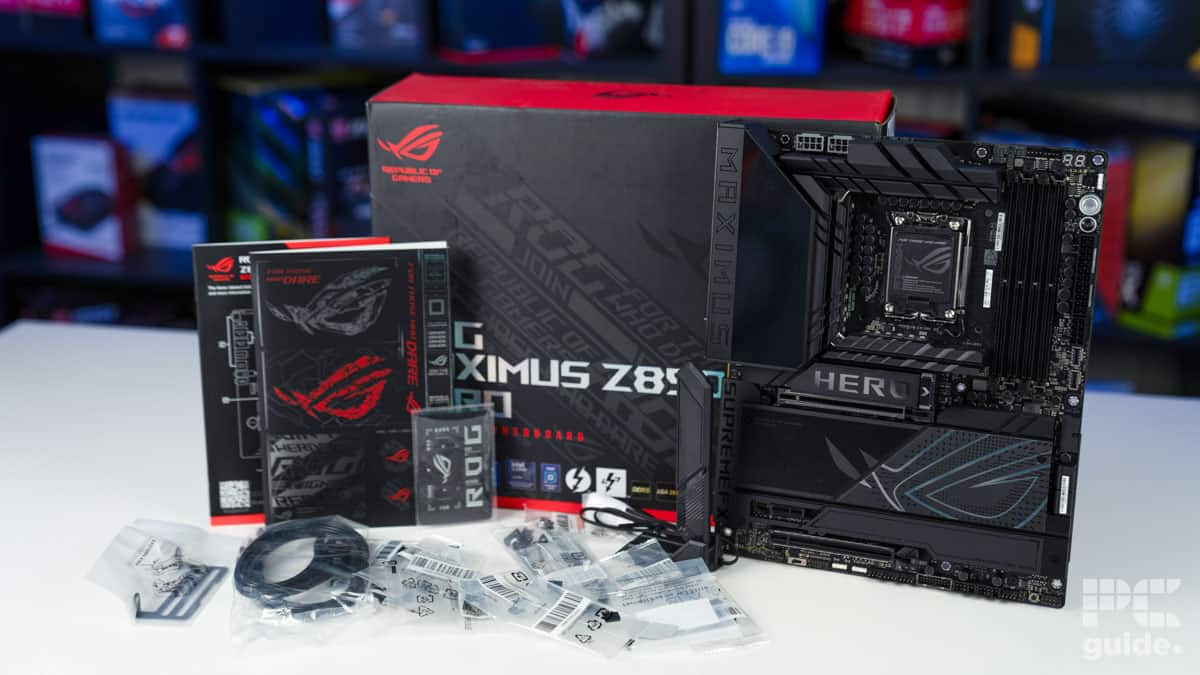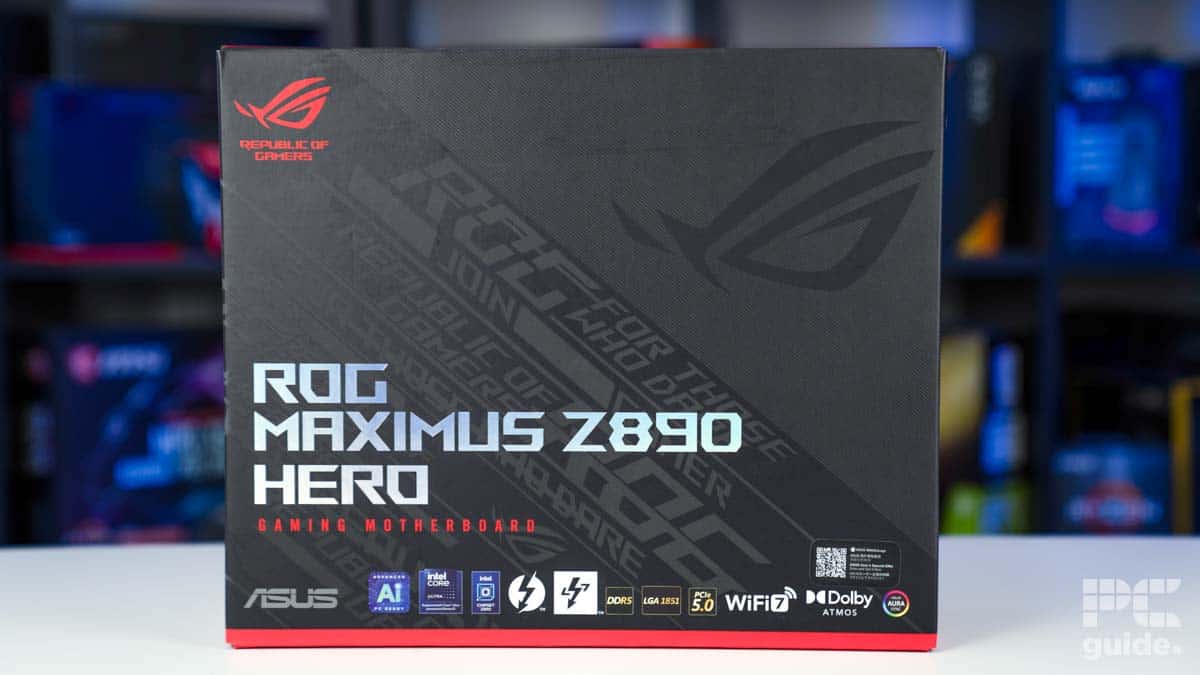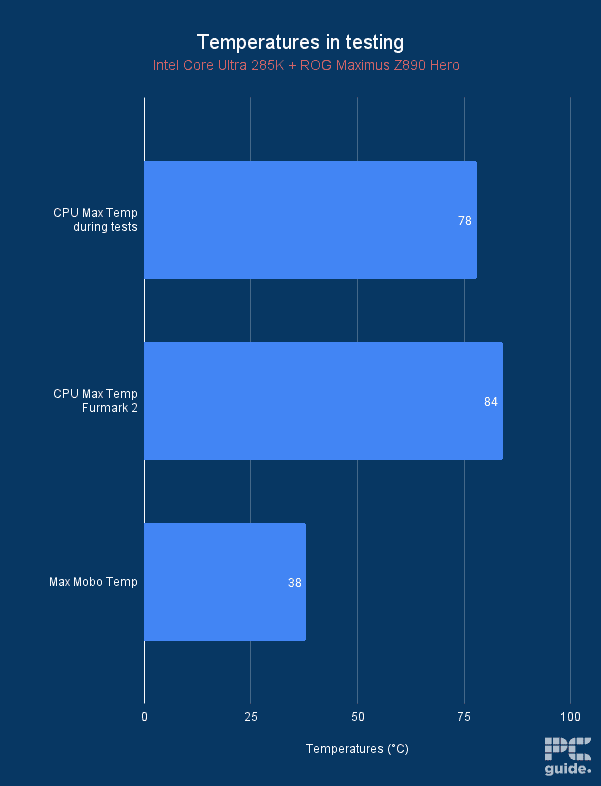ROG Maximus Z890 Hero review: an impressive and feature-rich motherboard for enthusiasts

Table of Contents
A new iteration of Intel CPUs is now out, which means that we have the next line of motherboards too. This time it’s the release of the Z890 chipset alongside the Intel Core 200 processors, which means I’m getting hands-on with the ROG Maximus Z890 Hero to find out what it is capable of and evaluate its design and features.
Z890 motherboards are setting the new standard for those who want to both future-proof their setups and gain access to the very latest components. They’re a big investment, so here’s how much bang you can get for your buck.
Prime Day is finally here! Find all the biggest tech and PC deals below.
- Sapphire 11348-03-20G Pulse AMD Radeon™ RX 9070 XT Was $779 Now $739
- AMD Ryzen 7 7800X3D 8-Core, 16-Thread Desktop Processor Was $449 Now $341
- ASUS RTX™ 5060 OC Edition Graphics Card Was $379 Now $339
- LG 77-Inch Class OLED evo AI 4K C5 Series Smart TV Was $3,696 Now $2,796
- Intel® Core™ i7-14700K New Gaming Desktop Was $320.99 Now $274
- Lexar 2TB NM1090 w/HeatSink SSD PCIe Gen5x4 NVMe M.2 Was $281.97 Now $214.98
- Apple Watch Series 10 GPS + Cellular 42mm case Smartwatch Was $499.99 Now $379.99
- ASUS ROG Strix G16 (2025) 16" FHD, RTX 5060 gaming laptop Was $1,499.99 Now $1,274.99
- Apple iPad mini (A17 Pro): Apple Intelligence Was $499.99 Now $379.99
*Prices and savings subject to change. Click through to get the current prices.

- Socket: LGA1851
- Chipset: Z890
- Form Factor: ATX
- PCIe Version: Gen 5 PCIe and Gen 5 NVMe
- VRM: 22+1+2+2
- Memory Speed: 9200+MT/s (OC)
- Memory Capacity: 256GB DDR5
The ROG Maximus Z890 Hero ticks all the right boxes for both experienced and first-time builders. It’s packed with features that make for easy installation, offers incredible cooling performance, and plenty of ports and connectivity. At a price point higher than the Ultra 285K, it’s an investment for sure, but one we’d say is worth making for enthusiasts.
- Great EZ release features on PCIe and NVMe slots
- Incredible cooling performance with massive heatsinks across the board
- Plenty of fast connectivity with PCIe Gen 5 and DDR5 support
- Lots of nice to have features for easy troubleshooting and building
- Incredibly expensive, even more than the top CPU that fits it
- Plenty of overkill for most builds with features that won’t be used
Design
The ROG Maximus is a full-on feature board. It’s designed to provide everything without shying away from cost or weight. One of the first things I noticed when unpacking the board was its sheer heft. Prying it out of the packaging takes some finesse thanks to its snug fit in the box – so heads up!
Once you do you can admire it in all its excellence. One thing that stands out is its big branding and more gamer-orientated design. For instance, the IO heatsink has the name of the motherboard with some lights behind it to show it off even more. That branding also continues on the lower heatsinks, as the NVMe and chipset covers.
Overall though, the motherboard certainly tries to hide the base PCB with all these covers and a vast amount of heatsinks on all the key components. It also packs a lot of connections around the edges in between all the metal plates covering it. This covering also extends to the back as it provides a good back plate to keep things safe and easier to handle.
It’s actually more of a stealth pick designed to blend in behind the rest of your components and not draw too much attention especially if you turn off the LEDs. I’d say it’s like a more built-up version of the ROG Strix X870E-E we reviewed not too long ago.
Specifications
| Socket | LGA 1851 |
| Chipset | Z890 |
| Form Factor | ATX |
| RAM | 4 x DIMM slots, max. 192GB DDR5 Support up to 9200+MT/s (OC) |
| VRM | 22(110A)+1(90A)+2(90A)+2(80A) |
| PCIe | 1x PCIe 5.0 x16 1x PCIe 4.0 x16 1x PCIe 4.0 x1 |
| Storage | 1x M.2 22110 (PCIe 5.0 x4) 2x M.2 2280 (PCIe 5.0 x4) 3x M.2 2280 (PCIe 4.0 x4) |
| Fan Headers | 1x 4-pin CPU Fan header 1x 4-pin CPU OPT Fan header 1x 4-pin AIO Pump header 4x 4-pin Chassis Fan headers 1x W_PUMP+ header |
| Connectivity | 2x Thunderbolt 4 USB Type-C ports 5x USB 10Gbps ports (4x Type-A + 1 x USB Type-C) 4x USB 5Gbps ports (4x Type-A) 1x HDMI port 1x Wi-Fi module 1x Intel 2.5Gb Ethernet port 1x Realtek 5Gb Ethernet port 2x Gold-plated audio jacks 1x Optical S/PDIF out port 1x BIOS FlashBack button 1x Clear CMOS button |
As expected for one of the top mobos, there’s plenty of connectivity, slots, and more on board. Starting off with the memory support, as Intel moves away from DDR4, it now fully embraces the DDR5 RAM generation. However, the native overclocking potential of the RAM has been increased as well, as it reaches over 9200MT/s with XMP enabled, so you can get a strong support component for your CPU.
It also doesn’t skimp out on the PCIe lanes and generations, as it brings PCIe Gen 5 connectivity to both NVMes and graphics cards at the same time. This gives you an option for future GPU generations, but plenty of options to plug in PCIe 5 NVMes and get the full speed available to your hardware.
That applies to the connectivity onboard as well, as it brings the latest WiFi 7 standard in wireless internet connectivity that is incredibly quick. Although if you prefer wired, it has both 2.5 and 5Gbps ethernet ports too.
Then the IO is rather numerous and quick too, as it offers up Thunderbolt, 10Gbps, and 5Gbps connections across the board. With a total of 11 USB connections, you should have plenty of options when plugging in peripherals. There is also plenty of audio potential with audio jacks and S/PDIF if you want a more advanced audio setup without needing much extra hardware.
Performance
| Component | Name |
| CPU | Intel Core Ultra 9 285K |
| GPU | RTX 4070 Ti |
| Memory | Corsair Dominator Titanium 64GB DDR5 @ 6800MT/s |
| Motherboard | ASUS ROG Maximus Z890 Hero |
| CPU cooler | Corsair Elite LCD Capellix 360mm |
| Power supply | ASUS ROG Thor 1000W |
| Case | Cooler Master Masterframe |
We put the motherboard to the test alongside our Intel Core Ultra 9 285K review, which is the top CPU for the new LGA 1851 socket. It does keep cooler compatibility at least so I didn’t need any new hardware to mount the 360mm AIO, so here’s how it faired in temps and power.
During my testing, the motherboard was capable of easily providing over 230W to the processor, with no issues. During this the temperatures have been rather low and tamed, especially on the motherboard. It maxed out at 38°C over the course of the range of tests and benchmarks.
That is likely thanks to the impressive arrangement of cooling over the whole motherboard. You’ve got a VRM design of 22+1+2+2, which allows it to keep the power running greatly without overheating, comvined with an lso that applies to the range of IO and NVMes to keep the temps under wraps for the range of hardware on board.
That also makes it an ideal solution for any hard overclocking you want to do, with the stable and highly effective cooling capabilities making it the ideal choice for the job.
Installation
This motherboard has a number of features that make it easy to install, especially for first time builders. One such feature is the simple integrated IO shield, which help alleviate any fear of forgetting to install one in your case.
It does also offer up plenty of quick-release features, such as with the NVMe SSD heatsink that you can simply take off with a latch and slide it out of place. You can also install the stick into place of the 2210 slot by just sliding it in the retainer without the need for screwing into place or any standoffs to worry about.
A similar solution can be found with the one PCIe slot for your GPU. It foregoes the button unlocker for the clip instead of going for a full latch-free solution, as it automatically holds in your card when it’s installed. This means you can also take it out without having to unlock it and just pulling from the port side will free the card, making it a lot easier for anyone to use.
Nice-to-have features
There are plenty of other features that are also included on the motherboard that might just justify the higher cost and quality. The back plate covers some sensitive solder points and is a good safety precaution especially when building for the first time, as you don’t want to short or break any pins on the back and ruin it. That back plate adds some heft and thickness but also offers some great protection.
Then on the front, you can find the segment display, a handy feature for diagnosing any problems with your build. It makes it a whole lot easier when it tells you where to start troubleshooting when something is going wrong. In the same vein, the IO panel includes buttons to make things clearer, such as the BIOS flash and Clear CMOS options. These make installation and troubleshooting that much quicker without having to consult the manual.
There are also the buttons on the front of the motherboard that allow for testing before having it fully installed, plus a flex key to do things your way too. It also offers plenty of connection points and ports to make any build possible, including loads of power ports.
CPUs to pair with this motherboard
If you’re looking at this motherboard, you’re going to need a good CPU to install into it. So here are a couple that you might consider pairing with the mobo, but the options are rather limited with only one generation released alongside them so far.
At the moment, the best option will be the Core Ultra 285K, the top processor from the Arrow Lake lineup. There is also the Ultra 7 265K as more of a mid-tier processor option. That being said, the matchup is a bit more difficult to justify.
-
Intel Core Ultra 9 285K
- Cores: 24
- Threads: 24
- Boost clock speed: 5.7GHz
- Base clock speed: 3.7GHz P-cores/3.2GHz E-cores
- L3 Cache: 36MB
- TDP: 125W base/250W max
-
Conclusion

- Socket: LGA1851
- Chipset: Z890
- Form Factor: ATX
- PCIe Version: Gen 5 PCIe and Gen 5 NVMe
- VRM: 22+1+2+2
- Memory Speed: 9200+MT/s (OC)
- Memory Capacity: 256GB DDR5
Overall, the motherboard is a rather expensive ask, and it’s certainly the more premium option out in the market. As with a $700 price point, you’re paying more for it than even the top processor that’s compatible with it. However, as a motherboard in general it’s a strong platform offering a lot of handy features that make building and troubleshooting all that easier. Top-tier performance potential and excellent for overclocking, this is a solid investment for enthuiasts if I ever saw one.

















